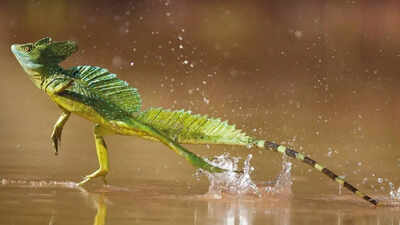 The basilisk lizard, often called the “Jesus lizard” or water walking lizard, is a truly remarkable species that fascinates scientists, wildlife enthusiasts, and engineers alike. Found in the lush rainforests of Central and South America, it inhabits rivers, streams, and wetland areas, where its extraordinary abilities are most evident. This lizard can sprint across water surfaces, an almost magical feat made possible by specialised toes with fringed scales, a lightweight body, and a balancing tail. These adaptations demonstrate a perfect combination of evolution, biomechanics, and survival strategy, allowing the basilisk to evade predators, access food, and navigate both terrestrial and aquatic environments efficiently. Its unique abilities continue to inspire scientific research and bio-inspired engineering.
The basilisk lizard, often called the “Jesus lizard” or water walking lizard, is a truly remarkable species that fascinates scientists, wildlife enthusiasts, and engineers alike. Found in the lush rainforests of Central and South America, it inhabits rivers, streams, and wetland areas, where its extraordinary abilities are most evident. This lizard can sprint across water surfaces, an almost magical feat made possible by specialised toes with fringed scales, a lightweight body, and a balancing tail. These adaptations demonstrate a perfect combination of evolution, biomechanics, and survival strategy, allowing the basilisk to evade predators, access food, and navigate both terrestrial and aquatic environments efficiently. Its unique abilities continue to inspire scientific research and bio-inspired engineering.
Natural habitat and aquatic adaptations of the basilisk lizard
Basilisks are predominantly found in tropical rainforest environments where rivers, streams, and wetlands are abundant. These water-rich habitats provide not only ample food sources such as insects, small vertebrates, and plants but also serve as safe escape routes from predators. The dense vegetation and constant humidity of rainforests create ideal conditions for the basilisk to thrive, hunt, and perform its signature water-running behaviour.The proximity to water is crucial because it forms the stage for their most famous survival technique. When threatened by predators, basilisks will often dash across rivers or floodplains to evade capture. This reliance on both aquatic and terrestrial habitats illustrates the lizard’s dual lifestyle and adaptation to complex ecosystems.
Anatomy and adaptations behind the basilisk lizard’s water walking skill
The basilisk lizard’s water walking skill is a marvel of natural engineering. Its feet are specially adapted for this purpose: each toe is elongated and fringed with tiny skin scales that expand when in contact with water, increasing surface area. When combined with the lizard’s rapid, springy strides, these fringes create small air pockets beneath the feet, which temporarily support the lizard’s weight and prevent it from sinking.The lizard’s lightweight body further enhances this ability, reducing downward force on the water. Its long tail acts as a dynamic stabiliser, helping maintain balance and direction during high-speed sprints. Together, these adaptations allow the basilisk to move across the water with astonishing speed, covering distances that often surpass several body lengths before eventually sinking if it slows down.
Science of running across water in basilisk lizards
Running on water is not just about anatomy; it involves a sophisticated understanding of physics in action. The basilisk lizard relies on a combination of speed, surface tension, lift, and force distribution. Its rapid steps create temporary lift, while the water’s surface tension provides resistance that prevents immediate sinking.Each foot strikes the water with a slapping motion, producing upward thrust while maintaining momentum. The tail’s swaying motion assists in steering and stability, ensuring that the lizard remains upright and moves efficiently. Biomechanics studies show that this coordinated interplay between limb movement, body weight, and water interaction is incredibly precise, making the basilisk one of the few species capable of true water running.
How running on water helps basilisks survive and thrive
The ability to sprint across water gives basilisks a unique evolutionary advantage. Predators such as snakes, birds, and larger mammals often cannot match the speed and agility of a lizard running across rivers or flooded terrain. This trait allows the basilisk to access food sources and territories that other reptiles might avoid.Beyond predator evasion, water running also facilitates foraging efficiency and territorial expansion. By combining aquatic and terrestrial mobility, basilisks occupy an ecological niche that few other species can exploit, demonstrating how evolution shapes survival strategies in diverse environments.
Conservation and ecological importance of the basilisk lizard
Although basilisk lizards are not classified as endangered, deforestation and habitat destruction pose serious threats to their rainforest ecosystems. Rivers and wetlands are particularly vulnerable to human activity, which can disrupt the delicate balance that allows these lizards to thrive.Protecting natural habitats ensures that basilisks continue to fulfil their ecological role, maintaining the food web and contributing to biodiversity. Furthermore, their remarkable biomechanics have inspired researchers in robotics and engineering, offering real-world applications of nature’s innovations. From understanding surface tension to designing bio-inspired robots, the basilisk lizard continues to provide lessons beyond biology.Also Read | The turtle that has NO gender at birth: How nest temperature decides male or female

